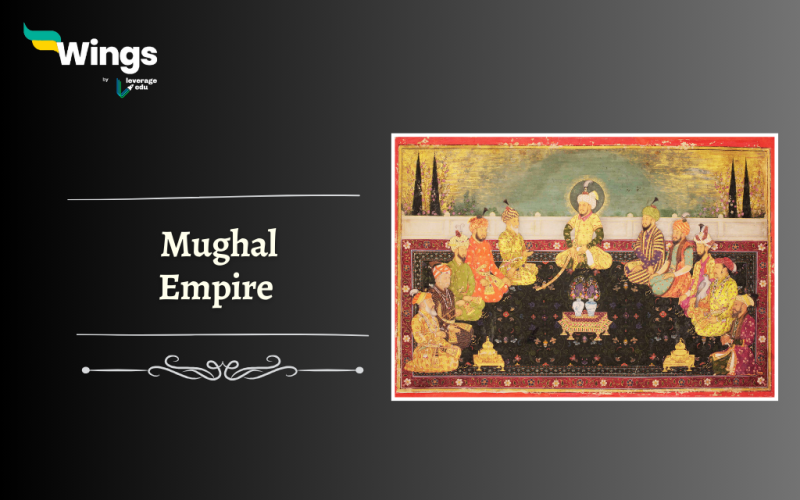The Mughal Empire was one of the most powerful and influential empires in India. The dynasty was the longest-reigning empire in India. From the 16th to the 19th century, the Mughal Emperors left a lasting legacy that still influences Indian culture and history today. In this article, we will delve into the different aspects of the Mughal Empire, exploring how it rose to power and how such a powerful dynasty declined.
Table of Contents [show]
Origins of the Mughal Empire
The Mughal Empire was founded in 1526 by Babur, a descendant of the Mongol ruler Genghis Khan and a Timurid Prince. Babur defeated the Sultan of Delhi, Ibrahim Lodhi, at the First Battle of Panipat, establishing the Mughal Empire in India in 1526.

Height of the Mughal Empire
- Under the rule of Emperor Akbar, the Mughal Empire reached its peak in the 16th century.
- Akbar implemented policies of religious tolerance and cultural integration, leading to a golden age of art, architecture and literature in the empire.
- The Mughal Empire under Akbar’s reign was characterized by flourishing trade, advanced infrastructure and efficient governance.
- Until the 7th generation, the Mughal Empire stood as a strong administrative force in Northern India.
- In the expansion of their kingdom, Mughal rulers indulged in battles and sieges with many other kingdoms which included the Battle of Panipat, Battle of Chausa, Battle of Kannauj, Siege of Ranthambore, Battle of Rohilla, Siege of Chittorgarh, etc

Administration and Governance of the Mughal Empire
The administration and governance in the Mughal Administration were streamlined and further disciplined during the rule of Akbar. There lay a ranking system from subedars to tehsildars in the administration.
- Divided into provinces known as “subahs,” each under the control of a governor appointed by the emperor.
- Akbar’s policy of sulh-i kul promoted religious harmony and unity among diverse communities.
- An efficient taxation system based on land revenue helped sustain the empire’s economy.
- The rank system of Mansabdari was also introduced under the Mughal rule
Also Read – Tughlaq Dynasty: Rulers of Delhi Sultanate
Military Strength
- The Mughal army consisted of infantry, cavalry and artillery units and skilled use of war elephants in battles provided a tactical advantage.
- Siege warfare tactics were employed to capture fortified cities and territories.
- According to historical accounts, nearly 911,400 to 4,039,097 infantry and 342,696 cavalry formed the military strength of the Mughal dynasty. The army of the dynasty is termed the largest military on Earth.

Cultural and Architectural Achievements
- Patronage of the arts led to the development of Mughal miniature painting and architecture.
- Landmark structures such as the Humayun’s Tomb in Delhi, Agra Fort, Buland Darwaza, Fatehpur Sikri, etc reflect the empire’s architectural intelligentsia and marvels of the period.
- The Urdu language emerged as a blend of Persian, Arabic and local dialects during the Mughal era.
Also Read – Gupta Empire: Rise, Rulers, UPSC Notes
Decline of the Mughal Empire
The decline of the Mughal Empire began in the late 17th century due to internal strife, weak leadership and invasions from foreign powers.
- The empire fragmented into smaller kingdoms, known as the Mughal successor states, which continued to rule over parts of India until the British colonization.
- Aurangzeb’s reign marked the beginning of the empire’s decline due to his strict policies and religious intolerance.
- Continuous invasions by Central Asian and European powers weakened the empire’s military capabilities.
- By the mid-19th century, the British East India Company had significantly reduced Mughal authority.
- The last Mughal ruler Bahadur Shah Zafar II was defeated and had to run to Burma to save his life.
Also Read – Important Notes on the Advent of Europeans in India
Legacy of the Mughal Empire
The Mughal dynasty left a significant impact on Indian society, architecture and culture.
- Mughal architecture, such as the Taj Mahal and Red Fort, exemplifies the grandeur and beauty of the empire’s aesthetic.
- Mughal art and literature, including miniature paintings and Urdu poetry, continue to be celebrated for their artistic achievements.
Also Read – Complete Mughal Empire List: An Overview
Key Emperors of the Mughal Empire:
- Babur (1526-1530): The founder of the Mughal Empire who laid the groundwork for future expansion.
- Akbar (1556-1605): Known as the greatest Mughal Emperor, Akbar’s reign marked a period of peace and prosperity.
- Jahangir (1605-1627): Jahangir was famous for his love of paintings and a folk tale of the love story between Salim and Anarkali.
- Shah Jahan (1628-1658): Mughal Emperor Shah Jahan is famous for building the Taj Mahal in memory of his wife Mumtaz Mahal.
- Aurangzeb (1658-1707): Known for his strict Islamic policies and the expansion of the empire through military conquests. Aurangzeb is also called the ruthless ruler among all the rulers.
In conclusion, the Mughal Empire List provides a glimpse into the rich history and grandeur of one of India’s most iconic dynasties. From its humble beginnings to its magnificent achievements, the Mughal Empire’s legacy endures through its architectural wonders, cultural contributions and complex administrative system. Despite facing challenges and eventual decline, the empire’s impact on Indian history and heritage remains significant.
Relevant Blogs
This was all about the Mughal Empire. If you want to know more about topics like this, then visit our general knowledge page! Alternatively, you can also read our blog on general knowledge for competitive exams!
 One app for all your study abroad needs
One app for all your study abroad needs















 45,000+ students trusted us with their dreams. Take the first step today!
45,000+ students trusted us with their dreams. Take the first step today!
